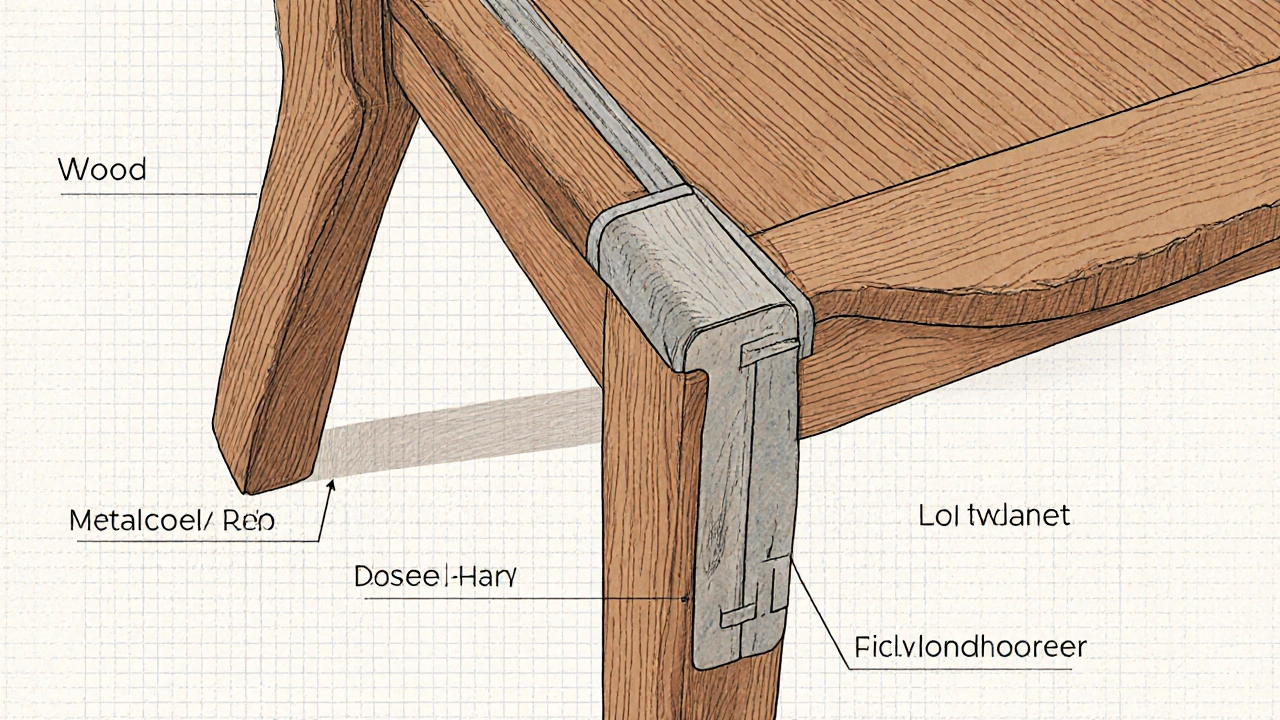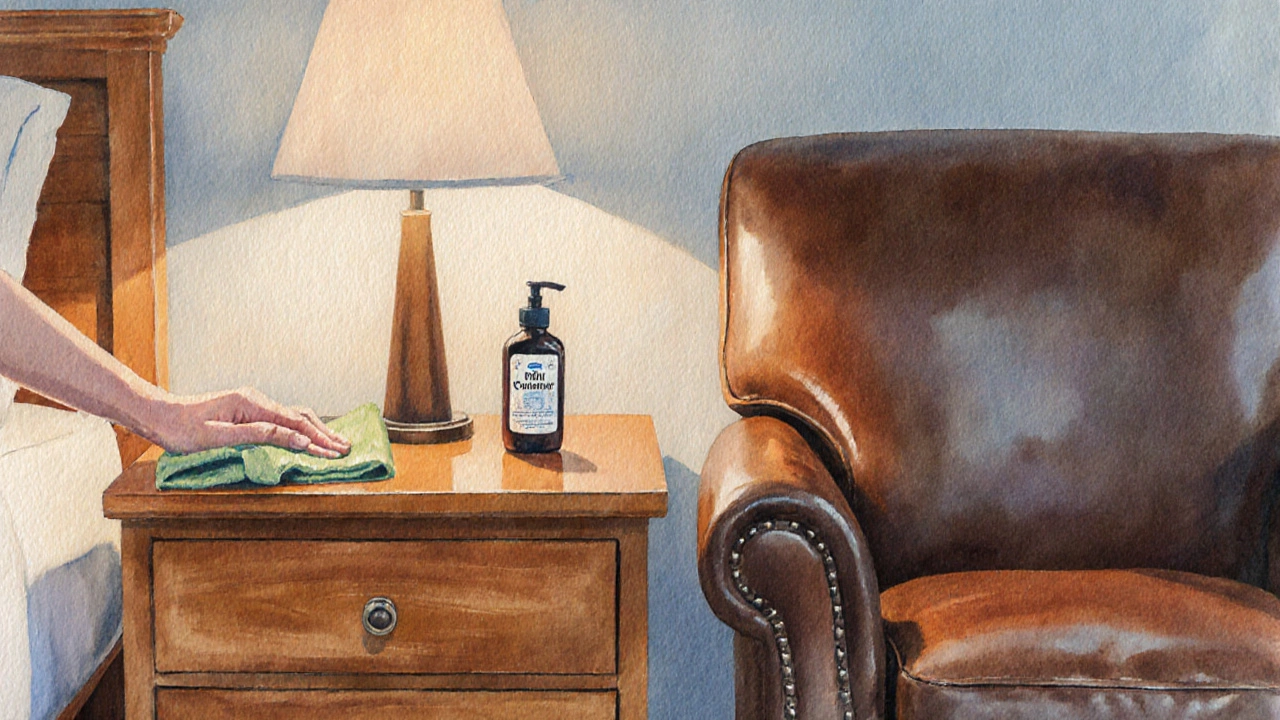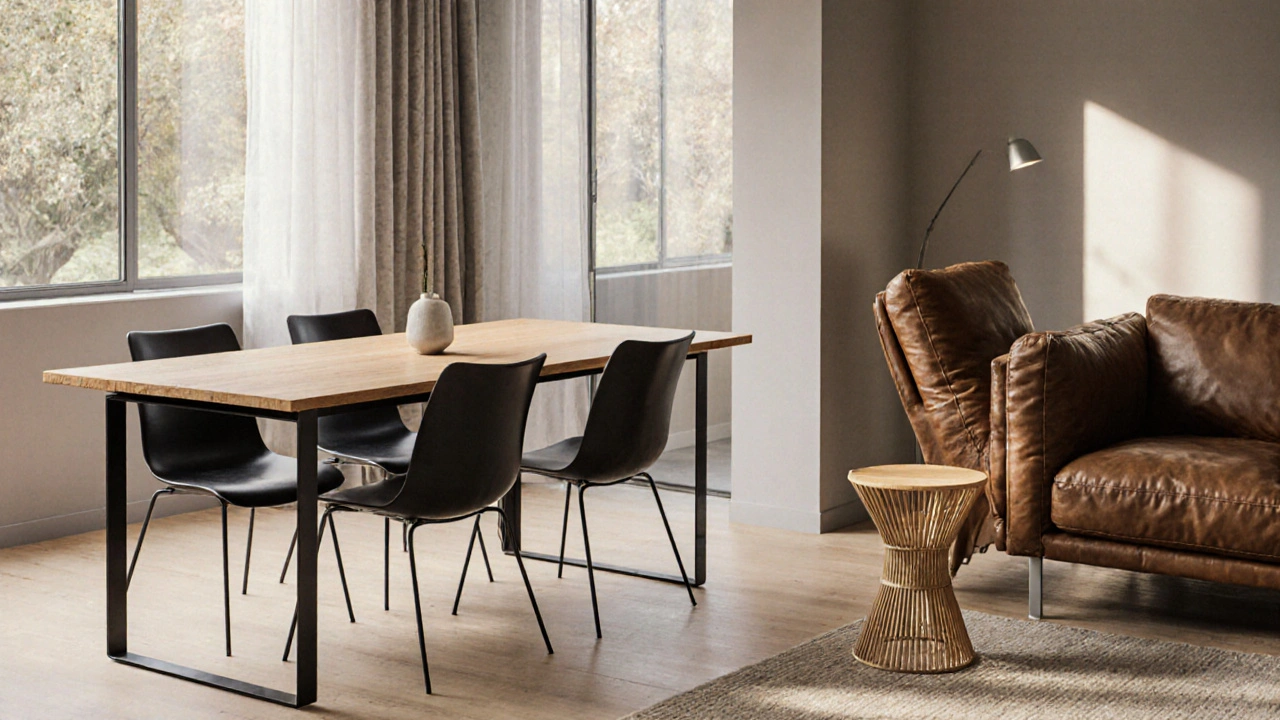Furniture Longevity Estimator
Estimate Your Furniture's Lifespan
Get a customized estimate of how long your furniture will last based on your usage, room type, and material choices.
Estimated Lifespan
Key Maintenance Tips
Cost Efficiency
Long‑lasting furniture is a type of furniture designed to endure years of daily use with minimal wear and tear. If you’ve ever bought a couch that sagged after a season or a dining table that warped in a few years, you know why durability matters. This guide breaks down the most resilient material choices, explains the construction tricks that add years to a piece, and gives practical upkeep tips so your home stays stylish without constant replacements.
Key Takeaways
- Solid wood, metal, and high‑grade leather top the durability rankings.
- Construction quality-joint type, frame reinforcement, and finish-often outweighs the raw material.
- Regular maintenance (dusting, tightening hardware, conditioning) can add a decade or more to most pieces.
- Budget‑friendly options like bamboo or reclaimed wood offer great longevity when built properly.
- Match material strengths to room demands: moisture‑resistant for bathrooms, wear‑resistant for high‑traffic living areas.
Understanding What Makes Furniture Durable
Durability isn’t just about the headline material. Three factors work together:
- Material density and natural resistance - denser woods, solid metals, and premium leathers resist dents and moisture.
- Construction methods - reinforced joints, dovetail or mortise‑and‑tenon connections, and sturdy frames keep pieces stable.
- Finish and treatment - protective coatings, oil finishes, or powder‑coated metals shield against wear and environmental stress.
When these three align, you get furniture that can survive families, pets, and the occasional spill.
Top Material Choices for Longevity
Below are the most common high‑durability materials, each introduced with schema microdata for easy knowledge‑graph extraction.
Solid wood is a natural timber cut directly from trees, prized for its strength, grain beauty, and the ability to be refinished many times. Species like oak, maple, and teak rank highest because of their tight grain and inherent resistance to warping.
Engineered wood refers to layers of real wood veneer glued together, such as plywood or laminated veneer lumber, offering consistent strength and lower cost. While not as robust as solid timber, high‑grade engineered boards can last decades when sealed properly.
Metal includes steel, iron, and aluminum components, recognized for their load‑bearing capacity and resistance to impact. Powder‑coated steel frames are especially durable in modern dining chairs and industrial‑style tables.
Leather is a natural hide treated to become flexible, breathable, and highly resistant to punctures and stains. Full‑grain leather ages gracefully, developing a patina that actually improves its look over time.
Upholstered fabric covers a range of woven materials like cotton, linen, and synthetic blends, each with varying abrasion resistance. Tight weaves and fabric blends with polyester or nylon fibers hold up best in high‑traffic sofas.
Bamboo is a fast‑growing grass that, when laminated, creates a strong, lightweight panel comparable to hardwood. Its natural moisture resistance makes it a smart choice for humid climates.
Reclaimed wood consists of salvaged timber from older structures, offering unique character and proven durability from its previous life. Properly refurbished, it can outperform brand‑new wood in stability.
Stainless steel is a corrosion‑resistant alloy often used for hardware, legs, and modern table tops, adding both strength and a sleek aesthetic. Its low maintenance nature makes it ideal for kitchens and outdoor settings.

Comparison of Material Durability, Cost, and Maintenance
| Material | Durability Rating (1‑5) | Typical Cost (USD) | Maintenance | Best For |
|---|---|---|---|---|
| Solid wood (oak, maple, teak) | 5 | $300‑$1500 per piece | Annual polishing, tighten screws | Dining tables, bedroom sets |
| Engineered wood (high‑grade plywood) | 4 | $150‑$800 | Wipe with mild cleaner, avoid water | Shelving, office desks |
| Metal (steel, iron) | 5 | $200‑$1200 | Dust, occasional wipe with damp cloth | Industrial chairs, outdoor tables |
| Leather (full‑grain) | 5 | $400‑$2500 | Condition quarterly, spot‑clean spills | Luxury sofas, accent chairs |
| Upholstered fabric (high‑twist polyester) | 3 | $200‑$1000 | Vacuum weekly, rotate cushions | Family room sofas |
| Bamboo (laminated panels) | 4 | $180‑$900 | Wipe with dry cloth, avoid prolonged water | Patio furniture, bedroom storage |
| Reclaimed wood | 5 | $350‑$1800 | Seal annually, tighten joints | Rustic tables, accent pieces |
How Construction Impacts Longevity
Even the toughest material can fail if the underlying build is sloppy. Pay attention to these details when you shop:
- Joint type: Dovetail, mortise‑and‑tenon, and metal brackets beat simple butt joints.
- Frame reinforcement: Look for double‑sided glue, wooden dowels, or screwed‑in metal brackets in tables and chairs.
- Leg design: Tapered legs on solid wood reduce stress points; metal‑to‑wood connections should have protective caps.
Ask sellers about the exact joint methods and whether any parts are glue‑only. If a piece lists “hand‑crafted with mortise‑and‑tenon joints,” you’re likely getting a longer‑lasting item.
Maintenance Tips to Extend Furniture Life
Maintenance is the secret sauce that turns a good purchase into a great investment. Here are proven steps you can adopt today.
- Dust regularly: Use a microfiber cloth to remove grit that can scratch surfaces. For wood, follow up with a light oil.
- Tighten hardware: Screws and bolts loosen over time. A quick check every six months prevents wobble.
- Condition leather and wood: Apply a quality leather conditioner once per quarter; for wood, use a beeswax polish annually.
- Control humidity: Keep indoor humidity between 40‑55% to avoid wood warping or metal corrosion.
- Use protective pads: Felt pads under heavy items protect floors and the furniture base.
Following these simple habits can add 10‑15 years to a sofa or dining set.
Choosing the Right Long‑lasting Furniture for Each Room
Different spaces face different stresses. Match material strengths to the environment.
- Living room: Opt for solid wood or metal frames with high‑grade upholstered cushions. If you have pets, leather or tightly woven polyester resists claws.
- Dining area: Hardwood tables with reinforced mortise‑and‑tenon joints survive daily meals and accidental spills. Pair with metal or solid wood chairs.
- Bedroom: A solid wood bed frame offers both support and style. Dressers benefit from bamboo for a lightweight yet sturdy feel.
- Home office: Metal or reclaimed wood desks handle the weight of computers and constant movement. Choose a matte finish to hide fingerprints.
- Outdoor patio: Look for stainless steel frames and bamboo tops that resist weather. Ensure any wood is treated with a marine‑grade sealant.

Cost vs. Longevity: When to Splurge and When to Save
Budget constraints are real, but the cheapest option often costs more in the long run. Use this rule of thumb:
Spend 30‑40% more on the core structural piece (frame, legs, top) and save on finishes or accessories.
For example, a solid oak dining table may cost $1200 versus $800 for a particleboard version. The oak table’s lifespan can be 30+ years, while the particleboard may need replacement in 8‑10 years. Over a 20‑year horizon, the oak saves you money.
Common Myths About Durable Furniture Debunked
- Myth: “All cheap furniture is junk.” Fact: Some engineered wood pieces, when properly laminated and sealed, perform surprisingly well for 12‑15 years.
- Myth: “Leather is high‑maintenance.” Fact: Full‑grain leather only needs quarterly conditioning and resists stains better than many fabrics.
- Myth: “Metal looks cold and fragile.” Fact: Powder‑coated steel is shock‑resistant and can be softened with cushions or wood accents.
Putting It All Together: Your Decision Checklist
- Identify the room’s stress points (moisture, traffic, weight).
- Choose a material with a durability rating of 4 or higher for that environment.
- Verify construction: look for reinforced joints, metal brackets, or solid cores.
- Factor in maintenance: can you commit to polishing or conditioning?
- Balance cost: allocate extra budget to the structural component.
Follow this checklist and you’ll pick pieces that stay beautiful for decades.
Frequently Asked Questions
Which wood type lasts the longest?
Hardwoods like oak, maple, and teak score the highest durability because of their dense grain. With proper sealing, they can endure 30‑plus years.
Is metal furniture really durable for indoor use?
Yes. Powder‑coated steel or stainless steel resists dents, scratches, and moisture. As long as the joints are solid, metal frames can last a lifetime.
Can I make a cheap upholstered sofa last longer?
Invest in a high‑twist polyester blend and rotate cushions weekly. Adding a slipcover and vacuuming frequently helps the fabric hold up for 8‑10 years.
How often should I refinish a solid wood table?
Every 5‑7 years, sand lightly and apply a fresh coat of oil or polyurethane. This restores the surface and prevents moisture penetration.
Is bamboo a good choice for humid climates?
Bamboo’s natural moisture resistance makes it ideal for humid areas, especially when laminated and sealed with a marine‑grade finish.


Scott Perlman
October 11, 2025 AT 01:05Great guide, definitely helpful.
Sandi Johnson
October 15, 2025 AT 05:46Oh sure, because everyone loves to pore over tables of wood durability before picking a coffee table.
Eva Monhaut
October 18, 2025 AT 17:06Reading through this guide feels like taking a mini‑course on furniture longevity. The breakdown of materials is crystal clear, and I love how each wood type gets its own spotlight. Solid oak, maple and teak aren’t just names-they’re the backbone of centuries‑old heirlooms. Seeing the durability ratings side by side makes the decision matrix less intimidating. The construction tips about dovetail and mortise‑and‑tenon joints are pure gold for anyone who values sturdiness. I also appreciate the reminder that a good finish can be a game‑changer, shielding pieces from everyday wear. The maintenance section is a treasure trove; a quick monthly dusting can add years to a sofa’s life. Your advice on humidity control resonates with me, especially after my bedroom’s wood floor warped once. The cost vs. longevity analysis hits the nail on the head-spending a bit more on the core structure really pays off. I never realized how bamboo, when laminated, can hold its own in humid climates. The outdoor patio recommendations are spot on, especially the marine‑grade sealant tip. The FAQs wrap everything up nicely, giving quick answers for the most common doubts. Overall, the guide balances technical depth with practical steps, making it accessible even for first‑time furniture shoppers. Thank you for the thoroughness; I feel equipped to make smarter purchases now. I’ll definitely share this with friends who are redecorating.
mark nine
October 22, 2025 AT 04:26One practical tip: keep a small screwdriver in your toolbox and tighten any loose screws on chairs every few months. It prevents wobble and extends the frame’s life.
Tony Smith
October 25, 2025 AT 15:46Indeed, allocating a modest increase of thirty‑percent toward a solid oak table while economizing on decorative trim epitomises the pinnacle of fiscal wisdom, does it not?
Ronnie Kaye
October 29, 2025 AT 02:06Sure, because nothing screams “I’ve got my life together” like a stainless‑steel dining set that never dents… unless you drop a whole pizza on it, then you’re golden.
Priyank Panchal
November 1, 2025 AT 13:26Stop believing the myth that cheap particleboard is forever-if you want durability, invest in real wood or metal, otherwise you’ll be replacing it every few years.
Tamil selvan
November 5, 2025 AT 00:46Dear readers, please consider the following recommendations: firstly, assess the humidity levels in your living space; secondly, choose materials with a durability rating of four or higher; thirdly, verify the presence of reinforced joints such as mortise‑and‑tenon; fourthly, schedule regular maintenance, including polishing and hardware tightening; finally, allocate additional budget towards structural components rather than superficial finishes.
Mark Brantner
November 8, 2025 AT 12:06Yep, just buy a lether sofa and it’ll last forever lol but jus kidding it needs care.
Kate Tran
November 11, 2025 AT 23:26That line is brilliant, totally captures the irony of “smart spending.”
Christina Morgan
November 15, 2025 AT 10:46I love the humor, but seriously, stainless steel does hold up great, especially with a good protector pad.
Kathy Yip
November 18, 2025 AT 22:06One might ponder whether the fleeting nature of cheap furniture mirrors the impermanence of modern consumer culture.
Bridget Kutsche
November 22, 2025 AT 09:26Thanks everyone for sharing insights; I’ll keep these tips in mind when my next couch needs an upgrade.